Posted by Elena del Valle on December 8, 2010
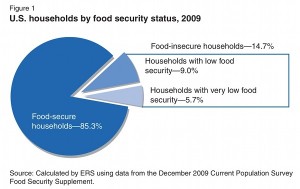
Click to enlarge
Graphic: U.S. Dept. of Agriculture
In 2009, 14.7 percent of residents of the United States or about 50 million people in the Land of Plenty suffered some form of hunger, representing the highest number of households suffering from hunger since 1995 when the first such survey took place. This included 5.7 percent of households where one or more household members ate less and their eating patterns were interrupted sometimes due to lack of money or food. The figures reflect no significant change compared to the previous year although 57 percent of all food-insecure households benefited from a Federal food and nutrition assistance program during the month prior to the 2009 survey.
Another way to look at it that last year only 85 percent of American households had access to enough food for an active, healthy life, according to the Household Security in the United States, 2009, a 62-page report written by Mark Nord Alisha Coleman-Jensen Margaret Andrews Steven Carlson and published by the United States Department of Agriculture (Nord, Mark, Alisha Coleman-Jensen, Margaret Andrews, and Steven Carlson. Household Food Security in the United States, 2009. ERR- 108, U.S. Dept. of Agriculture, Econ. Res. Serv. November 2010)
There were significantly more households with insufficient food than the national average among households with incomes near or below the Federal poverty line, among households with children, headed by single women (36.6 percent) or single men (27.8 percent), Black households (24.9 percent) and Hispanic households (26.9 percent). Households with low food resources were more prevalent than the national average (5.7 percent) for households with children headed by single women (12.9 percent), women living alone (7.4 percent), men living alone (7.1 percent), Black and Hispanic households (both 9.3 percent), households with incomes below 185 percent of the poverty line (14.4 percent), and households located in principal cities of metropolitan areas (6.8 percent).
The states with the highest percent of households with insufficient food were Arkansas (17.7 percent), Texas (17.4 percent) and Mississippi (17.1 percent); the states with the lowest percent of households where occupants went hungry in 2009 were North Dakota (6.7 percent), New Hampshire (just under 9 percent) and Virginia (9.2 percent). Some 17.7 million people (6 percent of Americans) compared with 1.3 million in 2008 had multiple times when they did not have enough food and could not afford meals.
Posted by Elena del Valle on November 29, 2010
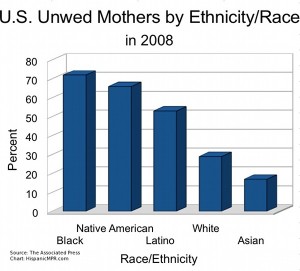
Click to enlarge
According to a recent Associated Press article (Rate of unmarried mothers reaches 72% among blacks), the offspring of unmarried mothers of any race are more likely than others to under perform in school, be imprisoned, use drugs, live in poverty as adults and have children while unmarried. In spite of the grim statistics 41 percent of mothers in the United States in 2008 were unmarried.
When we examine the statistics by racial and ethnic groups the figures are revealing. The most notable figure is among blacks where 72 percent of mothers that year were unwed. Still significant was that 66 percent of Native American and 53 percent of Latino mothers were unmarried. Twenty-nine percent of non Hispanic white mothers were unmarried that year. Asian moms were the least likely (17 percent) to have a child while unmarried.
Social attitudes toward marriage have changed in recent generations and being a single mother is much less frowned upon by society than in past decades. As women have become better able to make a living on their own their need to be married and have a husband in their lives for purely financial reasons has decreased significantly even if their earning power is lower than that of their male peers in many professions according to the Bureau of Labor Statistics (see Earning power for women stalls as pay scale still lags behind men at NJ.com).
At the same time, it is possible that some of the mothers in the Associated Press article statistics have significant others helping to raise the newborn. Some may find the high percent of unmarried mothers among historically Catholic Latinos surprising.
In some cases they make have a life partner but didn’t marry because they couldn’t afford the cost of a big wedding in the country of origin, according to an article about unmarried Hispanic mothers in Tennessee. Some even may be in a relationship where one of the partners may not be able to marry because they already have a spouse in their country of origin. Or they may be mimicking United States living together trends as part of the acculturation process.
Posted by Elena del Valle on November 24, 2010
Posted by Elena del Valle on November 15, 2010
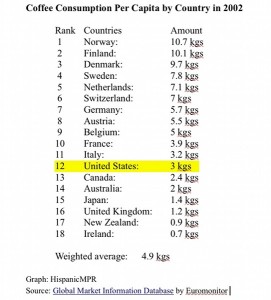
Click to enlarge
Photo: Nestlé
Americans consume a respectable amount of coffee although if we look at the big picture the amount of coffee the typical person in the United States drinks per capita is modest compared to that of many consumers in Western European nations. The top consumers by far are the Scandinavians. In 2002, Norwegians drank an average 10.7 kilos of coffee per person per year. Finland and Denmark were close behind with consumption around 10 kilos in each country. Dutch, Swiss, German, Austrian, Belgian, French and Italians were all ahead of the United States in coffee drinking, according to the Global Market Information Database by Euromonitor.
In 2009, in the United States daily consumption of coffee beverages among consumers remained consistent with 54 percent of the overall adult population partaking; cups-per-drinker and cups-per-capita held at the 2008 level and that of the previous four years, according to the National Coffee Association. While coffee consumption has held steady during the recession there are some consumption and purchasing trends worth noting.
Most people buy their coffee at the supermarket, according to the recent findings of Mintel, a research company. In the last five years this venue has grown 18 percent, reaching $3.4 billion this year. Another significant venue for retail sales are mass merchandisers and dollar stores. These venues grew 19 percent and reached $3.8 billion in 2010. The expectation for the immediate future is that the lower consumer confidence the greater the growth in these stores.
As people worry about the economy they migrate toward roasted coffee and other products they can brew at work and at home. If the worries deepen they are likely to seek value brands like Folgers and Maxwell House. FDMx sales of roasted coffee led overall market growth and grew 3.8 percent between June of 2009 and 2010. Folgers, part of J.M. Smucker Co. and seen by many as a strong United States brand, also had strong growth during those months. Kraft brands Maxwell House and Yuban also showed gains.

Sales of Nescafé Clasico increased 10.9 percent
In addition to the over 45 and over 55 market segments which exhibit the largest growth (see Baby Boomers biggest coffee drinkers, Emerging Markets likely to drive future growth), another segment expected to continue exhibiting high demand is Hispanics. FDMx sales of Nescafé Clasico, sometimes sold in bilingual packages, increased by 10.9 percent during the period examined by Mintel leading researchers to conclude that bilingual packaging may drive growth in instant coffee products which they found to be very popular among Spanish-speaking Latinos. Some marketers believe coffee sellers should enhance bilingual messages and packaging for instant coffee products popular among Spanish-speaking Hispanics. Nescafé Clasico, also available in Decaf and Suave flavors, is described on the Nestlé website as “the leading coffee for Latinos in the U.S.” and “the fastest growing brand in the instant coffee category with distribution nationwide in the U.S.”
Hispanics are more likely to drink coffee than non Hispanic whites, blacks and Asians. Among Asian coffee drinkers almost half buy whole bean coffee compared to 29 percent in the general population. According to Mintel, the research suggests that representations of Latinos should “often be included in advertisements as this helps to create brand relevance within the segment.” While among the general population 29 percent of buyers choose whole bean coffee, nearly half of Asian coffee-consuming households prefer whole bean coffee. Mintel researchers believe marketers should include Asians in advertising campaigns for whole bean coffee.
Fifty four percent of Latino Mintel survey respondents indicated they like non-sweetened instant coffee compared to 28 percent of the general population. About 70 percent of Spanish dominant Latinos (those who speak mostly or only Spanish), especially in Los Angeles, California and El Paso, Texas, like instant coffee.
Posted by Elena del Valle on November 8, 2010

Dunkin Donuts Hot Coffee and Iced Coffee Silo
Photos: Dunkin Donuts, Starbucks, Nespresso
If you are 45 and older and a coffee aficionado you are in good company. Fear not that your cup of jobe will disappear anytime soon. The number of coffee drinkers and the amount of coffee they drink has remained about the same in the last few years. Adults 45 and older, especially those 55 and older, are where the highest demand for coffee is today. This market segment is likely to drive coffee sales between 2010 and 2015.
Think the price of good old coffee has skyrocketed? You are right. Growth in the coffee market lately has been driven mostly by the higher prices paid for coffee. A more modest percent of the growth is from coffee lovers’ increase in consumption.

Starbucks Mocha Light Frapuccino
It is true that the economic downturn has resulted in a reduction of ready-to-drink (RTD) coffee purchases. As Americans watch their wallets and their waists demand for some sugary RTD products and heavily processed related products that are expensive and high in calories may continue to wane.
Before adjusting for inflation, retail sales of coffee including ground, whole bean, instant and RTD products grew 19 percent in five years, from $6.1 billion in 2005 to $7.2 billion in 2010, according to recent data from Mintel, an international research company.
An example of this has been the United States invasion by Swiss coffee maker Nespresso. In the last years the company which tightly controls sales of its coffee making machines that only accept Nespresso capsules sold exclusively at brand boutiques and by mail has made significant inroads in the luxury coffee market. Nestlé owned Nespresso has 190 boutiques in 50 countries, according to the company website.
“While we have grown exponentially in the United States over the past few years, there is still a large, un-tapped coffee-loving population that is not engaged in the Nespresso brand,” said Frederic Levy, president, Nespresso North America, in a press release. Company representatives did not respond to requests in writing and phone calls to the multinational’s Swiss headquarters and North American offices.

Nespresso machines only work with Nespresso capsules sold exclusively by Nespresso
There are 13 Nespresso stores in North America. Of those, there are 10 company operated boutiques in the United States, including Nespresso’s flagship Boutique Bars in New York City and Miami, and one in Boston as well as a Boutique-in-Corner location at Sur La Table in Scottsdale, Arizona, and five Boutique-in-Shop locations at Bloomingdale’s in SoHo, New York, Chevy Chase, Maryland, Chicago, Illinois, and San Francisco and Costa Mesa, California.
In the first half of this year Nespresso’s sales in the United States and Canada increased 45 percent. Levy indicated in a Reuters interview in September 2010 that his company is targeting annual growth of 35 percent in the region for the next five years, hoping there is continuing demand for high end coffee products.
Mintel experts expect coffee sales growth to continue steadily over the next five years. Notable exceptions are instant coffee (except among Hispanics), which has exhibited a decline in the past five years and RTDs which are expected to show only minimal growth in the next few years.
As older adults’ consumption wanes today’s young coffee drinkers and their preferences will become more attractive to coffee sellers. According to the Mintel study, young adults and teens consume much less coffee than older adults often preferring energy drinks to coffee. When they drink coffee they do so at cafes where they often select cream and sugar enhanced coffee drinks like Starbucks’ Frappuccino. Tea, especially among Asians, is another competitive product. Forward planning coffee companies may wish to launch products to target these desirable market segments.
Hispanics, according to popular belief and the Mintel study, love coffee. Because this market segment is booming, along with other emerging markets (Asians, African-Americans and Hispanics account for 80 percent of the growth in the United States according to the Geoscape 2010 American Marketscape DataStream report), it will probably be behind a significant part of the anticipated coffee products growth in the next five years.
Posted by Elena del Valle on October 29, 2010
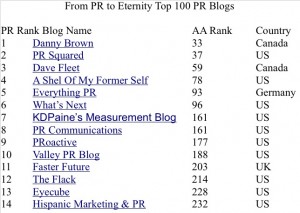
HispanicMPR.com listed in fourteenth place of Top 100 PR Blogs at From PR to Eternity (http://www.fpte.co.uk/2010/01/12/worlds-top-100-pr-blogs-january-2010/), Matthew Watson’s blog.
Watson explains that “The list is by no means perfect since it only features blogs on the AdAge Power 150 with PR, Public Relations, Publicity or Flack in the title, and a few others that have been suggested to me by commenter’s. Although it’s just a bit of fun I think it’s still a fairly decent indicator of the world’s top PR blogs.”
A senior account executive at Speed Communications, Watson writes about online marketing and public relations. A while back he compiled a list of what he thought were the top public relations blogs listed on the AdAge Power 150. The list is, according to his site, still one of the most popular pages on his site.
Posted by Elena del Valle on October 11, 2010

Is it possible, like in the popular television program Lie To Me, to identify words (in the show they use nonverbal cues) to know when someone, especially a senior executive, is lying? Can a simple analysis of executives’ language separate truthful executives from fibbers accurately?
David F. Larcker and Anastasia A. Zakolyukina, graduate business students at Stanford, analyzed the language used by chief executives (CEOs) and chief financial officers (CFOs) in the United States between 2003 and 2007 by examining the transcripts of 30,000 quarterly earnings conference calls. They assumed that CEOs and CFOs would be aware of any manipulation of the company’s financial records. They relied on psychological studies that indicate when people may be fibbing by examining the language they use to draw conclusions about the conversations.
The two students shared their thoughts in a 69-page paper titled Detecting Deceptive Discussions in Conference Calls published July 2010 at the Stanford Graduate School of Business. They believe their linguistic classification models have an above average accuracy rate of between 50 and 65 percent.
It appears the deceptive executives are more likely to make more references to general knowledge (“as you know…”), refer less to shareholder value, and use fewer “non-extreme positive emotion words” to “sound more persuasive” while bluffing. Also, they use the third person and avoid saying “I.”
The researchers believe the executives on the calls rehearsed or were possibly coached because they relied less often on “hesitation words” such as “um” and “er.” According to their analysis, the pattern of lies is different between CEOs and CFOs.
At the same time the authors of the paper were unable to separate those who knowingly lied from those who did so unwittingly. They believe lack of context and background detract from the findings. In their conclusion they point out that because the large sample they used for their research is of big and profitable firms they may not expand their conclusions to the general population of companies.
Critics (see “How to tell when your boss is lying,” The Economist August 19, 2010) point out that although the results of the study are significant eventually the executives will just seek out more and better public relations coaches to help them prepare and carry out their deceit more effectively than during the calls examined in the study by preparing them to say the things that are expect of truthful speakers.
Posted by Elena del Valle on September 27, 2010
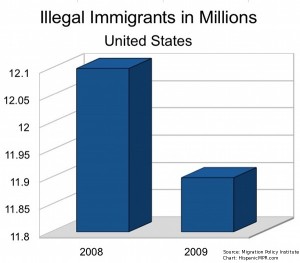
Illegal Immigrants United States 2008-2009 – click to enlarge
As the recession hit the United States it also affected employment including employment of the undocumented. In spite of all the controversy around Arizona’s anti illegal immigrant legislation and federal troops heading to our southern borders there are fewer illegal immigrants in our country now than in recent years.
According to the Migration Policy Institute, a Washington, DC organization, the number of foreigners illegally in the United States is down from an estimated 12.1 million in July 2008, to 11.9 million a year later, and less now. Another telltale indicator that immigrants, like everyone else, have been affected negatively by the economy is the drop in remittances from the United States south. The Institute website sites anecdotal evidence that some Mexican families have sent money to their relatives in the Unites States to help them. Even the demand for visas was down compared to previous years, according to visa statistics sited by the Institute.
Because many immigrants share demographic characteristics with the groups most likely to be affected by the recession such as youths, the uneducated, and new members of labor force often they have been more likely to be victims of the recession; and foreign-born workers are also overrepresented in the construction, manufacturing, leisure and hospitality, and support and personal services industries which have been especially affected by the downturn in the economy, according to the Institute.
The United States is not alone in dealing with immigration issues. A report published recently by the Organization for Economic Co-operation and Development (OECD), which tracks changes in 29 developed countries, indicates that in 2008 the migration of people to developed countries decreased 6 percent to 4.4 million and probably fell more last year. In the five years prior to the recession, movement of migrants into developed countries was high. In spite of the economic hardships few, including the illegal immigrants in the United States, returned to their countries of origin.
Posted by Elena del Valle on September 20, 2010
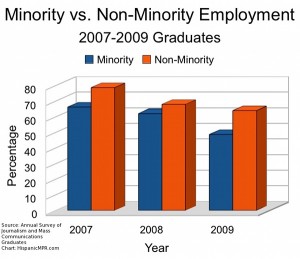
Click to enlarge
Declining media coverage due to fewer and smaller media outlets has affected marketing and media relations, particularly in the last few years. Further evidence of that is the decline, partly because of the recession, of employment opportunities for journalism and communications university graduates. This may have a medium and long term effect on others who deal with and rely on journalists and communicators to make their living.
In addition to the many challenges resulting from the changes in media formats and workforce reduction in recent years journalism graduates, especially those from ethnic and racial backgrounds, are encountering difficulties finding gainful employment in their area of study. A new report by the University of Georgia resulting from a survey of 2,700 journalism and mass communication students who graduated in 2009 revealed the lowest level of full-time employment in the 24-year history of the study.
Of the 2009 journalism and communication bachelor degree holders who responded to the survey only 55.5 percent were able to find full-time work within a year of graduating. That represents 4.9 percentage points decline from the year before. It is also significantly different from the 2007 figures when 70.2 percent of graduates found employment. Graduates receiving a masters degree also had trouble finding work; the employment rate dropped from 65.4 percent in 2008 to 61.9 percent in 2009.
Ethnic and racial minorities, according to the survey results, suffered more than other graduates. Only 48.6 percent of 2009 minority graduates compared with 63.9 percent of non-minority graduates found full time work. The 15.3 percent difference was three times as large as the gap between minority and non-minority graduates of the previous year (5.9 percent), representing the largest difference in the history of the University’s survey.
Also, survey responses indicate an increase in the number of 2009 graduates working with the internet. More than half (58.2 percent) of 2009 bachelor graduates with communication jobs said their work involved Web writing and editing compared to 50.6 percent who said that the year before.
The Annual Survey of Journalism & Mass Communication Graduates is conducted each year in the James M. Cox Jr. Center for International Mass Communication Training and Research at the University of Georgia. This year’s report was written by Lee B. Becker, Ph.D. Tudor Vlad, Ph.D., Paris Desnoes and Devora Olin.
Posted by Elena del Valle on August 30, 2010

BlackBerry cell phone
Photos: AT&T, Verizon
An increasing percentage of people in the United States is taking advantage of cell phone and wireless laptop access to the internet. According to the results of a Pew Research Center’s Internet and American Life Project survey released in July 2010, 59 percent of adult respondents said they access the internet with a wireless system through a cell phone or laptop computer. In 2009, 51 percent of survey respondents said they accessed the internet with a wireless system through a cell phone or laptop computer.
In the last year, 47 percent of adults said they went online with a laptop WiFi connection or a mobile broadband card. This represents an increase compared to 39 percent who said they did that in April 2009; 40 percent said they access the internet, email or instant messaging on a mobile phone compared with 32 percent who said they did that in 2009.

Verizon and ZTE USA AD3700 USB modem
People are also using non voice phone applications more than in the past. More people are taking pictures, 76 percent compared to 66 in April 2009; 72 percent send or receive text messages compared to 65 percent in 2009; 38 percent access the internet compared to 25 percent in 2009; 34 percent play games compared to 27 percent in 2009; 34 percent send or receive email compared to 25 percent in 2009; 34 percent said they record a video compared to 19 percent in 2009; 33 percent said they play music compared to 21 percent in 2009; and 30 percent send or receive instant messages compared to 20 percent in 2009.
Contrary to a recent Pew Hispanic Center report that indicated Latinos lag behind in their use of technology compared to the general population (see Latinos lag behind in use of technology compared to non Latinos), in this survey researchers concluded that African-Americans and English-speaking Latinos, remain among the most active users of these technologies. The Pew Hispanic Center report included Spanish dominant Latinos while this one only mentioned English speaking Latinos. More African-Americans and Latinos, 87 percent, own cell phones than whites 80, according to the survey responses.
They also use more of their phone’s features compared with white mobile phone owners. This year more African-Americans (64 percent) said they access the internet from a laptop or mobile phone, compared to 57 percent who said they did in 2009.
“The Hispanic consumer market is one of the fastest growing in the U.S. and is very attractive to wireless providers, not just in terms of growing population but also in terms of usage. Hispanics over-index in almost every category: They use more minutes, they make more long-distance calls, they text more, and they download more ringtones” said Kelly Starling, spokesperson, AT&T.
The report, Mobile Access 2010, released July 7, 2010 is based on the findings of a daily tracking survey on Americans’ use of the internet. The data is from telephone interviews, in English, of 2,252 adults 18 years old and older conducted by Princeton Survey Research Associates International between April 29 and May 30, 2010.






















